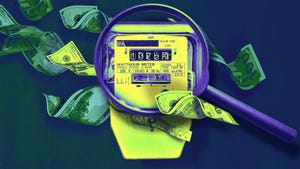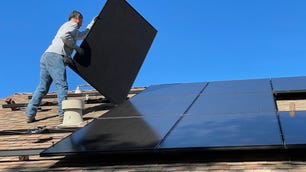The Real Costs of Going All-Electric and How You Can Save

When it comes to future-proofing your home and saving money on energy bills, home electrification is all the rage. But going all-electric has some upfront costs that might give you sticker shock. Thankfully, there are plenty of financial incentives up for grabs.
There are many reasons to electrify: “Most people are motivated to save money on energy bills. It’s appealing to use less energy and get the same, or better level of comfort,” Alex Amend, director of communications at Rewiring America, told CNET. “There’s also a lot of people who are motivated by making a climate impact as well.”
However, even with these motivations, there’s still a hesitancy to adopt new technologies. A recent survey found that 43% of Millenial and Gen Z participants are hesitant to invest in home electrification upgrades due to stories of buyer’s remorse. The survey also found that 76% of Baby Boomers are concerned about the upfront costs of these home upgrades.
Even when faced with large upfront costs, rising energy prices and climate concerns make home electrification feel like a shiny solution. But where do you start, and is it really worth the hassle? Here’s what to know about the home electrification journey.
The home electrification journey
Home electrification isn’t a step-by-step process. Instead, it’s more of a puzzle. You start with one piece and create the whole picture in a way that makes sense for your needs.
“There is not a one-size-fits-all here. Very few people can take on all of these projects at once. That’s why the tax credits are designed for 10 years, so you can do it when you are ready,” said Amend.
You might start electrifying your home because your furnace needs to be replaced. But instead of buying another gas-powered furnace, you might choose to install a heat pump that uses electricity to heat and cool your home. When the savings start rolling in, it’s time to search for the next energy-efficient home upgrade. However, every home is different, so every person’s electrification journey will look a bit different. Your neighbor might start with something as simple as an electric lawn mower and then decide to get an electric vehicle.

Considering Solar Panels?
Our email course will walk you through how to go solar
The average family could save about $1,000 to $2,500 per year with whole home electrification upgrades, according to data from Rewiring America. That adds up to potential savings of $15,000 – $37,500 over 15 years (or the lifespan of your air conditioner).
While the upfront costs might still be a concern, “You also should consider the opportunity cost. You won’t have to replace a furnace and can save on electricity costs when you’re using energy from the sun,” Patrick Donahue, chief product officer at Aurora Solar, told CNET. “It’s not just the sticker price of the upgrade but also how much you will save over its lifetime.”
Electrification incentives
The federal government provides several incentives through the Inflation Reduction Act to reduce the cost of energy-efficient home upgrades. And you could find even more tax credits and rebates from your state and local governments. Understanding what’s available in your area can make going electric more affordable and might save you some hassle.
These are just a few tax credits from the IRA for home electrification projects:
- New electric vehicle: Save up to $7,500
- Heat pump air conditioner and heater: Saveup to $2,000
- Heat pump water heater: Save up to $2,000
- Weatherization or insulation: Save up to $1,200
- Rooftop solar: Save up to30% of the total cost of a solar panel system
- Electrical panel: Save up to $600
The cost of home electrification projects
The price you’ll pay and the potential savings you’ll see from home electrification upgrades will vary based on where you live, the difficulty of the project and the incentives available in your area. Here are some home electrification projects, the best time to start upgrading and the estimated cost, based on data from Rewiring America.
Get a home energy audit
The first thing you should do is get a home energy audit. This can help you understand how electricity is used in your home and where improvements can be made to improve your home’s energy-efficiency. The whole process should only take two or three hours. Some electric utilities even offer free energy audits.
When to get an energy audit: Purchasing a new home, preparing for electric upgrades or having unexpectedly high energy bills.
Cost: $0 – $900, depending on location and available incentives or rebates.
Take a look at your electric panel and wiring
When you switch out your gas-powered appliances for electric ones, you’ll be using more electricity to power your home and may need a new electric panel. An electrician can rewire your home for current efficiency upgrades, as well as help prepare your home for future energy needs.
When to upgrade: Before starting any home electrification projects.
Cost: $4,800–$11,000
Install electric appliances
Electric clothes dryers and induction or conventional stoves don’t burn fossil fuels and require less energy to operate. They also don’t release toxic pollutants into your home, creating a healthier living environment.
When to upgrade: Your current gas-powered appliance is near the end of its lifespan.
Cost: Over $400 per appliance, depending on the model and brand. Total cost can range from $1,000 – $1,300.
Purchase an electric lawn mower
Electric lawn mowers let you mow your grass efficiently and quietly without polluting the air. Instead of filling it up with gas, you’ll just plug it into an outlet to charge up. For a cordless mowing experience, just charge the battery.
When to upgrade: Your current lawn mower is worn out, or you’re ready for an energy-efficient upgrade.
Cost: This will costat least $175.
Install a heat pump water heater
Heat pump water heaters use less heat because they transfer heat from the air, rather than generating heat, making them more efficient. The average lifespan of a heat pump water heater is about 10 to 15 years. You’ll need a plumber or HVAC professional to help you install it.
When to upgrade: Your current water heater is about 10 years old.
Cost: $3,000 – $5,900
Upgrade to a heat pump and weatherize your home
Heating and cooling your home is more efficient with a heat pump versus using gas furnaces or oil. Weatherization projects, like air sealing and upgrading windows, can also reduce the amount of energy used to keep your home at a comfortable temperature. These projects require an HVAC contractor to assist with installation.
When to upgrade: After having your current HVAC system for about 15 years. Do weatherization projects when it’s best for you.
Cost: Around$14,500 – $17,300. Incentives and rebates are available
Purchase an electric vehicle
CNET did the math and found that charging an electric vehicle is cheaper than filling up a gas tank, allowing you to save money on fuel expenses over time when you purchase an EV. Driving an EV also reduces your carbon footprint and is better for the environment.
When to upgrade: You’re ready to replace your gas-powered car or purchase an additional vehicle. You also might want to consider renting an EV for a few days before committing to a purchase.
Cost: Averages at $55,353 before incentives and varies by make and model.
Install solar panels
You can install solar panels on your roof to power your home with clean energy from the sun and reduce your reliance on fossil fuels. After reaching your solar system’s payback period, you can save thousands on electricity costs. Going solar can be very expensive, so make sure to receive quotes from several installers — don’t just go with the first quote you receive.
When to upgrade: Any time, as long as your roof is in good condition and there’s room in your budget.
Cost: Varies by location and other factors, but the national average cost of a residential solar installation is $31,558, according to data from FindEnergy.

Home electrification tips
Rewiring America offers several resources to learn about home electrification, including project planning tools and checklists to stay organized.
“I’m never going to say that going electric is easy, but that’s why we build these tools. You want the best technology that delivers comfort and doesn’t pollute your home. All of that involves electrification,” Amend said.
Here are a few tips to consider when electrifying your home:
- Get a home energy audit: Scheduling a home energy audit helps identify ways to improve your home’s energy efficiency and determine a good starting place for electrification based on your home’s energy needs.
- Assess current appliances and HVAC units: Evaluatethe age and efficiency of your current home appliances. Identify those nearing the end of their lifespan and start researching electric alternatives and incentives to be ready for a smooth transition when replacements are needed.
- Explore payment options: If paying upfront is not in your budget, consider financing options like Fannie Mae’s HomeStyle Energy Mortgage or Freddie Mac’s GreenCHOICE Mortgage. These programs can include energy-efficient improvements in your mortgage at lower interest rates for a home purchase or refinance. You can also use a home equity loan to borrow money against the equity of your house to pay for upgrades. Just keep in mind that if you can’t make payments, you could lose your home.
- Find incentives: Research available tax credits, rebates and local benefits to save money on home upgrades. You can use Rewiring America’s incentive calculator and the Database of State Incentives for Renewables and Efficiency to find incentives in your area.
- Plan for future needs: When making decisions about energy-efficiency upgrades, consider your current and future energy needs, such as purchasing an EV or installing solar panels. Planning ahead for your energy-efficient home ensures it can support these changes smoothly and affordably.
- Find knowledgeable contractors: Work with experienced contractors who can plan for your future needs, so you keep saving money on energy bills.
Preventing buyer’s remorse
When it comes to buyer’s remorse in the home electrification space, it’s less about regretting the money spent and more about what could have been done differently to maximize the benefits. Karen DeVincent-Reinbold, director of communications at Aurora Solar, experienced this during her home electrification journey.
“I wish I had sacrificed a couple of panels and gotten a second battery,” she said. “[My solar panel system] overproduces and could have benefited more from storage.”
The journey can also bring unexpected challenges, like finding someone to remove a propane gas tank when you’re installing a heat pump. “Some Millennials say their electrification journey involved unanticipated work, like having to open walls to install ductless heat pumps or dealing with the local town hall to get permits,” Donahue said. “Homeowners can benefit from access to a solution that makes planning more efficient and systemic, to avoid these costs.”
When you’re diving into an electrification project, especially solar panel installation, getting help from an experienced contractor can help you prepare for future needs, like purchasing an electric vehicle or installing a heat pump. These additions require more electricity. If you want to cover your energy usage with solar, you’ll need a certain system size to meet your home’s growing energy needs.
You might even want to see if you can get a trial run with some of these products before making anything permanent. Try driving an EV or using a neighbor’s electric stove before deciding if it’s right for you.


